Understanding ABA and Its Significance in Inclusive Classrooms
Applied Behavior Analysis (ABA) has become a cornerstone in special education, especially supporting children with autism spectrum disorder (ASD) and other developmental disabilities. Recognized as the 'gold standard' of autism treatments, ABA's research-backed strategies focus on fostering meaningful behavioral and skill development, ultimately enhancing learning outcomes and quality of life for students with diverse needs.
Foundations and Principles of ABA Therapy in Education
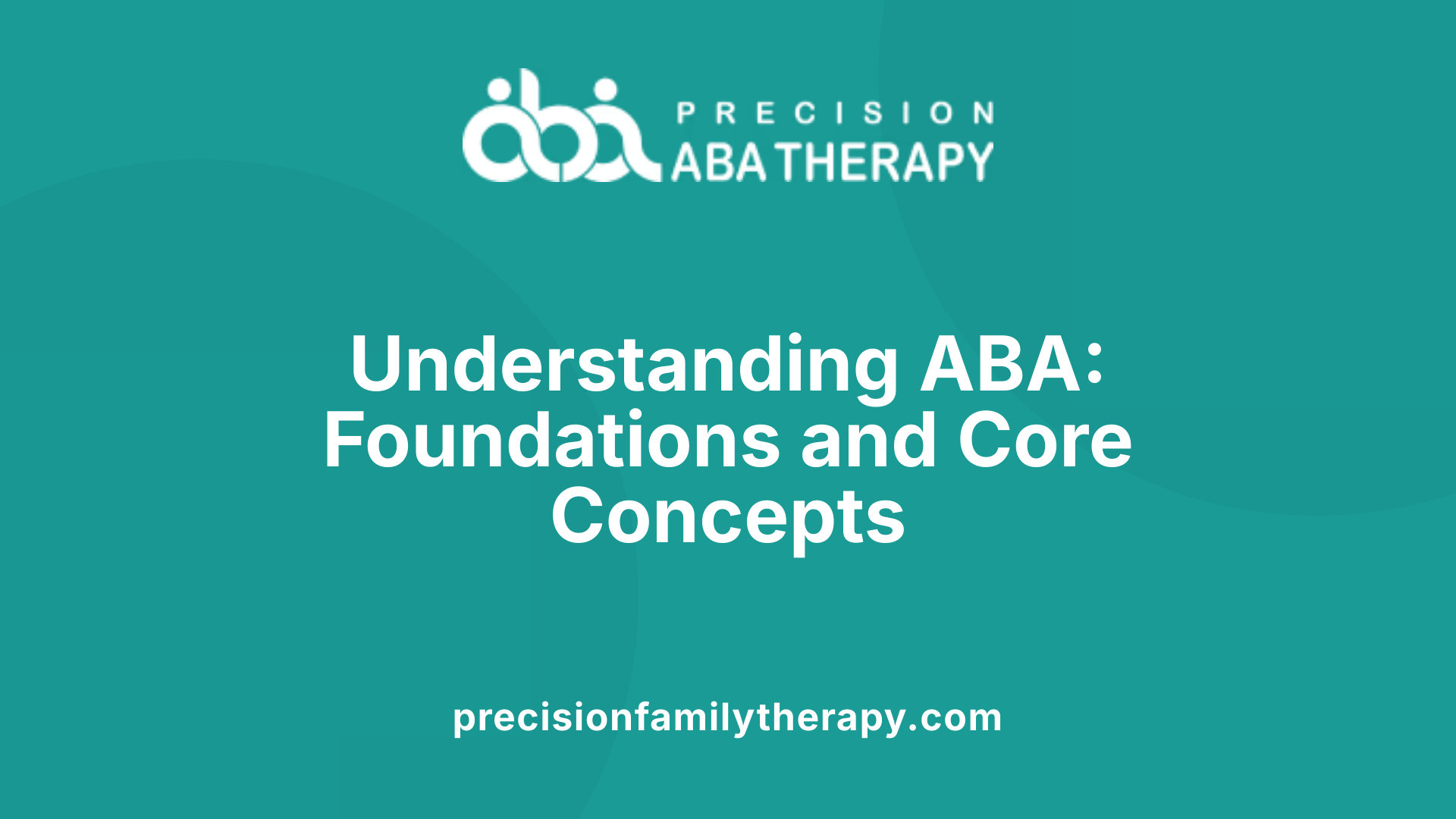
What is ABA therapy in special education?
Applied Behavior Analysis (ABA) is a scientific, evidence-based approach used mainly to support children with autism spectrum disorder (ASD) and other developmental challenges. It involves carefully assessing a child's behaviors, strengths, and needs to develop customized intervention plans. These plans aim to improve communication, social, and daily living skills, while reducing harmful behaviors.
ABA therapy employs several specific techniques, such as Discrete Trial Training (DTT), Pivotal Response Treatment (PRT), and Natural Environment Training (NET). Each method serves different aspects of learning and is selected based on what best helps the individual child.
The primary goal of ABA is to promote independence and improve quality of life. Therapists and trained professionals, like Board Certified Behavior Analysts (BCBAs), work closely with children, families, and educators to set achievable goals and track progress rigorously. Early and intensive intervention, often more than 20 hours a week for children under age 4, can lead to meaningful developmental improvements.
Overall, ABA in special education is about creating a supportive, tailored environment where children learn socially important behaviors and skills that enable them to participate more fully in their communities and classrooms.
Core principles such as positive reinforcement and data collection
At the heart of ABA are foundational concepts such as positive reinforcement and meticulous data collection. Positive reinforcement involves rewarding desired behaviors to increase their occurrence. Rewards can include praise, toys, treats, or social recognition. For example, a child who uses words to request something may receive their favorite toy as a reward.
This approach is supported by decades of research and is proven to be effective in changing behaviors. Reinforcement is used not only to teach new skills but also to encourage continued use over time.
Data collection is an essential part of ABA, involving the systematic recording of behaviors and responses. This data helps therapists and educators understand how well interventions are working, identify patterns, and adjust strategies as needed.
Behavioral data is often gathered through direct observation and recorded in charts or software. It enables precise monitoring of progress and ensures that interventions are based on objective evidence rather than assumptions.
Environmental variables influencing behavior
ABA theory emphasizes the significant impact of environmental factors—called antecedents and consequences—on behavior.
Antecedents are events or conditions that occur before a behavior and can influence whether that behavior happens. Teachers and therapists can modify antecedents by adjusting instructions, setting clear expectations, or creating structured routines to increase the likelihood of positive behaviors.
Consequences are what follows a behavior and can shape future actions. Positive consequences, like praise or tokens, reinforce desired behaviors, while negative consequences or mild punishments may decrease undesired behaviors.
By modifying environmental factors, educators can help facilitate better behavior and learning outcomes. For example, reducing distractions in a classroom or providing visual schedules can help children with ASD stay engaged and respond appropriately.
In summary, ABA relies on understanding and manipulating environmental variables, using reinforcement and data-driven strategies, to support meaningful behavioral change in school settings.
| Concept | Description | Example |
|---|---|---|
| Positive Reinforcement | Reward to increase behaviors | Praise for sharing toys |
| Data Collection | Systematic recording of behaviors | Charting frequency of tantrums |
| Antecedents | Events before behavior | Clear instructions before a task |
| Consequences | Events after behavior | Token reward for completing homework |
This structured approach helps teachers and therapists create effective, individualized education plans, promoting positive development for students with autism and other special needs.
Applying ABA Strategies Within Classroom Settings
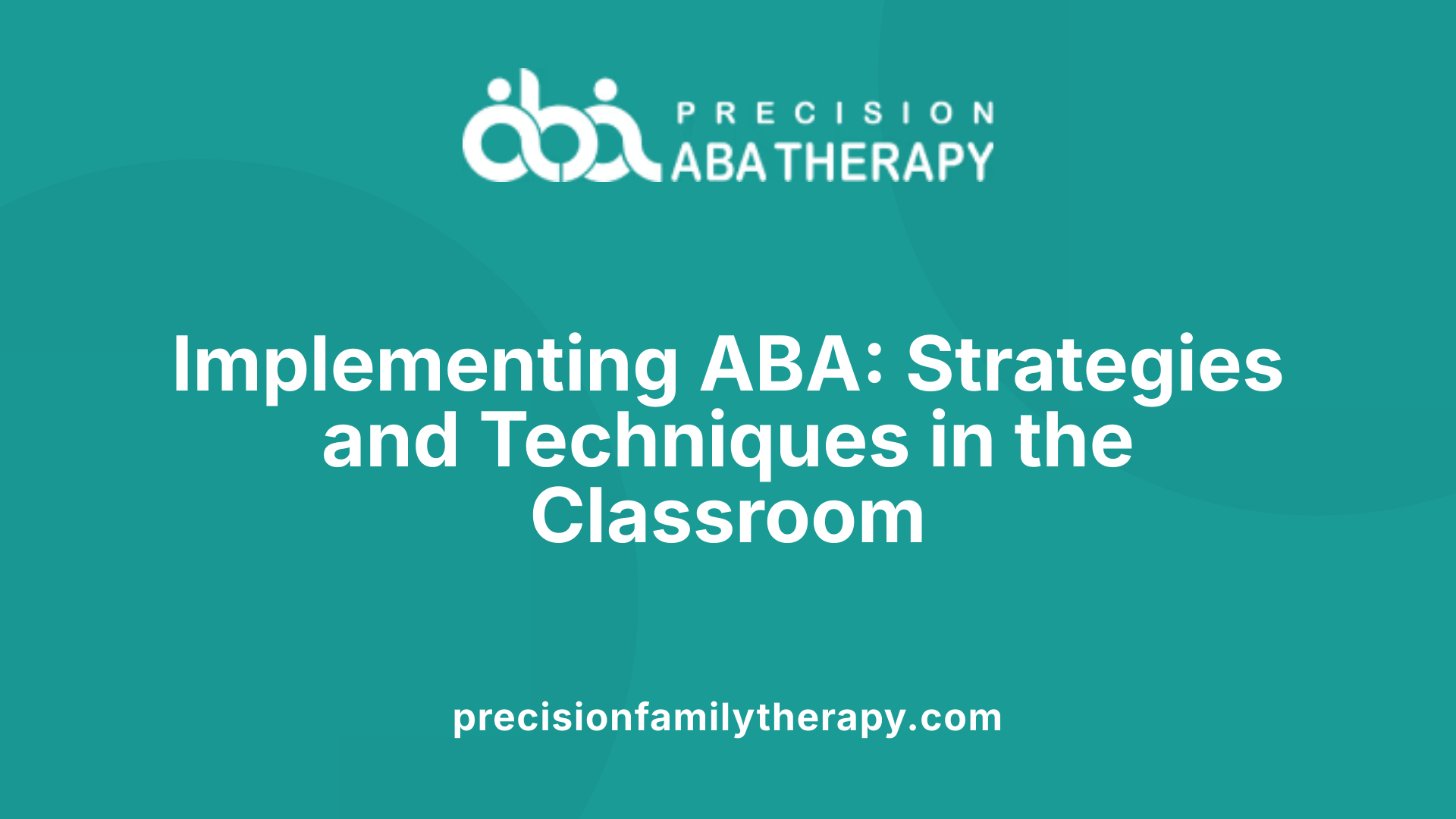
How is ABA therapy applied within classroom settings for children with developmental disabilities?
ABA therapy in classroom environments uses various research-backed techniques to enhance learning and social behavior. One common method is Discrete Trial Training (DTT), which involves breaking down complex skills into small, manageable steps. During DTT, the teacher or therapist presents a clear instruction or cue, waits for the child's response, and then provides reinforcement or correction based on the behavior. This structured, repetitive process helps children acquire and practice new skills efficiently.
Natural Environment Training (NET) leverages everyday classroom activities and the child’s interests to promote spontaneous communication and social interaction. Instead of structured trials, NET encourages learning in less formal, more engaging settings, making skill generalization more effective. Pivotal Response Treatment (PRT), another important approach, focuses on pivotal areas such as motivation, self-initiation, and responsiveness. By targeting these pivotal skills, PRT aims to produce widespread improvements across various behaviors.
Reinforcement plays a central role in ABA classroom strategies. Teachers and staff often use positive reinforcement, like praise, tokens, or preferred activities, to encourage desirable behaviors. Modifications to antecedents, such as adjusting instructions or environmental cues, help set the stage for positive responses. Such modifications make it easier for children to understand expectations and act accordingly.
Data collection and progress monitoring are integral to effective ABA application in schools. Educators and therapists regularly record data on each child’s responses and behaviors, allowing for tracking improvements over time. These data inform decision-making, helping to modify interventions to better suit each student’s evolving needs. Progress reports, functional behavior assessments (FBAs), and ongoing observations ensure that interventions remain personalized and effective.
Implementation techniques like DTT, NET, and PRT
| Technique | Focus Area | Typical Setting | Goal | Description |
|---|---|---|---|---|
| Discrete Trial Training (DTT) | Skill acquisition | Structured lessons | Learn new skills effectively | Breaks skills into small steps, repeated trials, clear cues, reinforcement |
| Natural Environment Training (NET) | Spontaneous communication | Play, routines | Promote generalization and spontaneous use of skills | Learning in natural, real-life settings aligned with child’s interests |
| Pivotal Response Treatment (PRT) | Motivation and socialization | In classroom, home, community | Broad skill development | Focuses on highly motivating activities, encourages child-initiated behaviors |
Role of reinforcement and antecedent modifications
| Strategy | Purpose | Example | Expected Outcome |
|---|---|---|---|
| Positive reinforcement | Encourage desired behavior | Giving praise or tokens | More frequent occurrences of desired behaviors |
| Antecedent modification | Set up environment for success | Simplifying instructions or providing visual cues | Improved understanding and compliance with tasks |
Use of data collection and progress monitoring
| Data Type | Purpose | Tools Used | Importance |
|---|---|---|---|
| Response data | Measure performance | Checklists, data sheets | Guides intervention adjustments |
| Behavior frequency | Track behavior patterns | ABC data, charts | Helps identify triggers and effective strategies |
| Goal achievement | Assess progress | IEP goals, benchmarks | Ensures goals are being met |
In summary, ABA strategies in classroom settings involve careful planning and the use of tailored techniques such as DTT, NET, and PRT. Reinforcement, antecedent modifications, and ongoing data collection create a structured environment that fosters meaningful behavioral and skill development for children with developmental disabilities.
Benefits of ABA in Special Education Classrooms
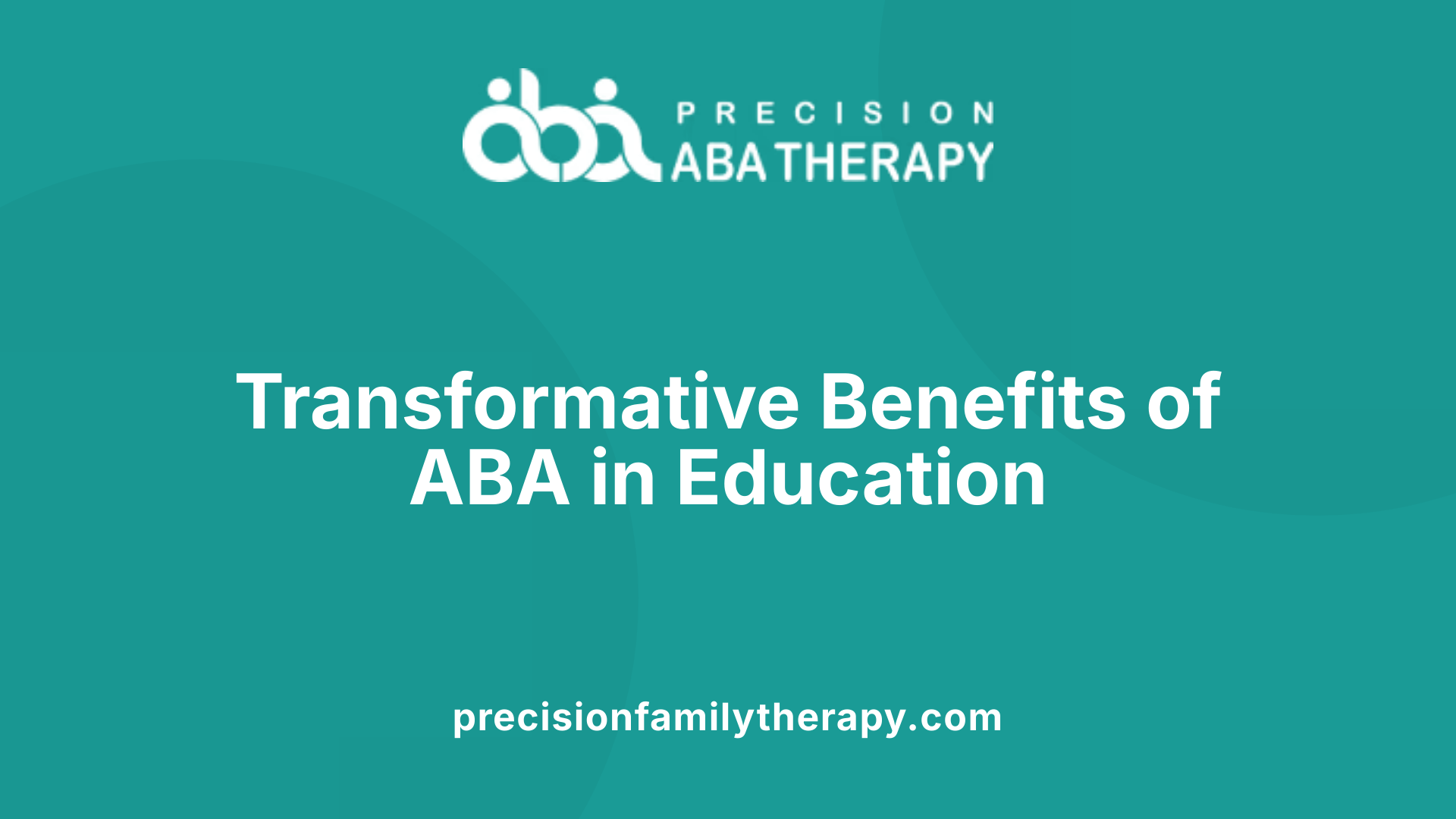
What are the benefits of implementing ABA therapy in special education classrooms?
Applying ABA (Applied Behavior Analysis) in special education settings offers a range of significant advantages. Since ABA is grounded in scientific principles of learning and behavior, it enables educators and therapists to create tailored interventions that address each child's unique needs.
One of the most notable benefits is the improvement in social, communication, and behavioral skills. ABA techniques help children develop more effective ways to interact with peers and adults, leading to better social integration. By using positive reinforcement, children learn desirable behaviors such as sharing, taking turns, and expressing themselves more appropriately.
ABA's structured approach supports reducing problematic behaviors like tantrums, aggression, or inattentiveness. It breaks down complex behaviors into smaller, measurable units, which makes progress tracking and adjustments more manageable. This data-driven method ensures that interventions are constantly refined for optimal effectiveness.
Enhanced academic achievement is another important benefit. ABA strategies integrate with classroom instruction, fostering active learning and engagement. For example, discrete trial training or natural environment training can directly teach academic skills in controlled or naturalistic settings.
Promoting independence and life skills is central to ABA's goals. Children learn practical skills such as dressing, eating, self-regulation, and problem-solving, which are crucial for daily functioning. These skills help children participate more fully in routine activities and prepare them for future independence.
Creating a structured, positive learning environment is vital for children with disabilities. ABA emphasizes consistent routines, clear expectations, and reinforcement of appropriate behaviors, which contribute to a calm and predictable classroom atmosphere. Visual supports, token economies, and behavior charts often accompany ABA strategies to motivate and guide students effectively.
The holistic impact of ABA extends beyond immediate skill acquisition. It fosters positive behavioral habits that promote social acceptance and academic success. Teachers and therapists employing ABA are better equipped to implement inclusive practices, support diverse learning styles, and foster a nurturing environment where children with disabilities can thrive.
In summary, the application of ABA in special education classrooms leads to improved social interactions, enhanced communication, effective behavior management, increased independence, and the development of key academic skills. Its scientific foundation and adaptability make it a valuable approach for helping children with various developmental challenges reach their full potential.
Supporting Learning and Behavior with ABA
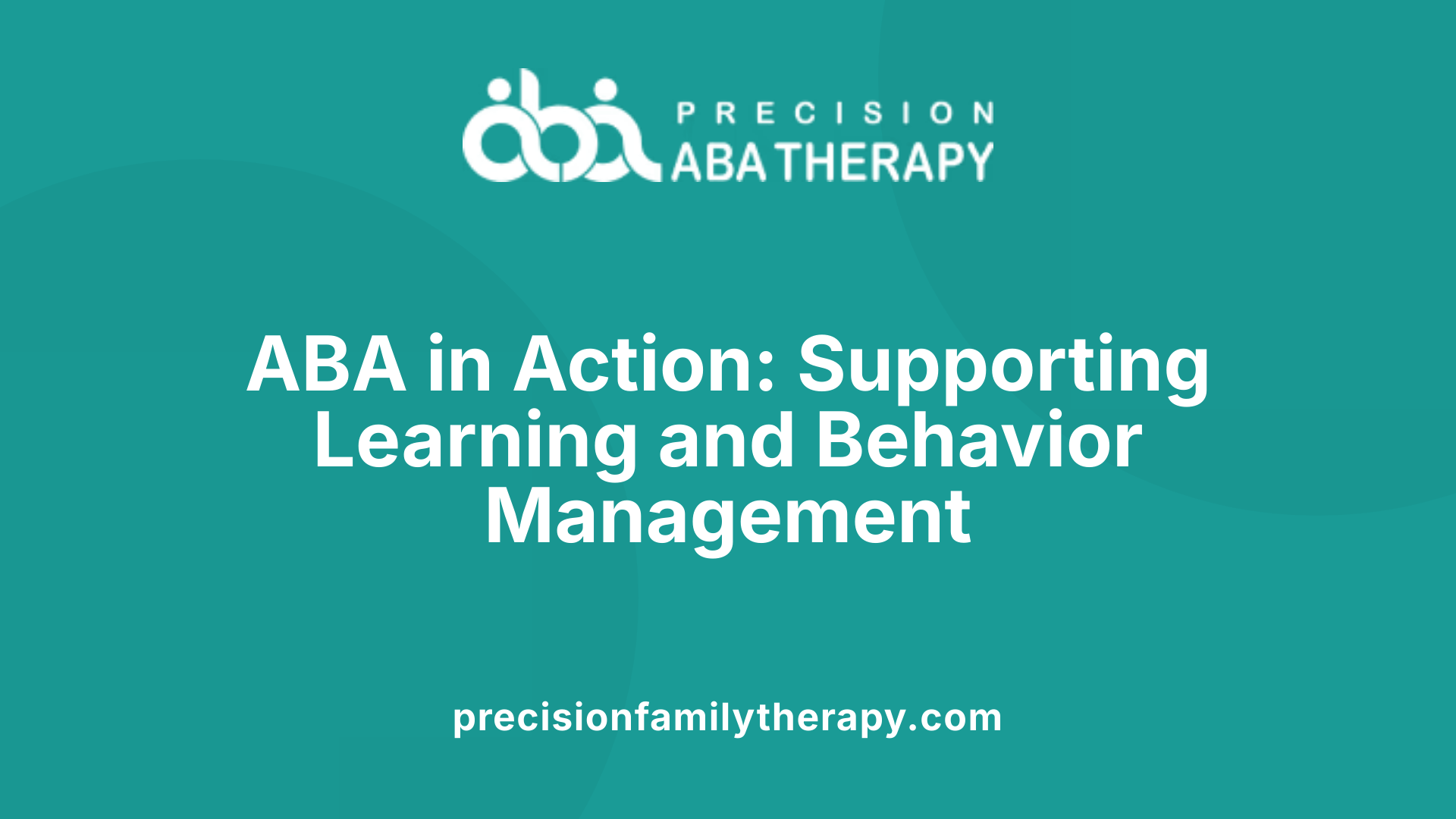
How does ABA therapy support learning and behavior management in students with special needs?
Applied Behavior Analysis (ABA) is a scientifically proven approach that significantly aids children with autism spectrum disorder (ASD) and other developmental challenges. Its primary goal is to help children develop essential communication, social, behavioral, and daily living skills while reducing unwanted or disruptive behaviors.
ABA therapy offers personalized intervention plans that are based on thorough assessments of each child's strengths and needs. Therapists and educators set collaborative goals with parents, ensuring that interventions are tailored to the child's unique profile. These goals focus on increasing helpful behaviors and decreasing harmful ones, through techniques grounded in behavioral science.
One of the core methods used in ABA is positive reinforcement. Children are rewarded with treats, social praise, or preferred activities to encourage the repetition of desirable behaviors. For example, a child may receive praise for sharing toys or using words to communicate needs. Tasks are often broken into small, manageable steps through a process known as task analysis, making learning more accessible and manageable.
ABA interventions are data-driven. Practitioners systematically record behaviors, collect progress data, and use this information to refine strategies. They evaluate the antecedents – the environmental cues or triggers before a behavior – and consequences, such as rewards or penalties, which influence future actions. By modifying these environmental factors, ABA helps create a supportive learning space that motivates positive change.
ABA isn’t limited to clinical settings; it is effectively implemented in homes, classrooms, play areas, and community environments. Such natural applications enable children to generalize learned skills across different settings, improving their overall functioning.
In school environments, ABA techniques support inclusion and academic success. Teachers are trained to incorporate strategies like discrete trial training (DTT), pivotal response treatment (PRT), and natural environment training (NET). These methods help students stay engaged, follow routines, and interact socially with peers. As a result, students exhibit fewer problem behaviors, become more organized, and participate more actively in classroom activities.
Promoting independence is a vital aspect of ABA. Children learn to perform daily tasks such as dressing, eating, and self-regulation. These skills foster autonomy and confidence, which are crucial for successful integration into society.
The effectiveness of ABA has been reinforced over decades of research, with the 1999 Surgeon General’s report affirming its capacity to reduce inappropriate behaviors and enhance communication and social skills. Overall, ABA creates a structured and encouraging environment that supports meaningful progress for children with special needs, empowering them to reach their full potential.
Effective Strategies for ABA Implementation in Classrooms
What strategies are used to apply ABA effectively in educational environments?
Applying Applied Behavior Analysis (ABA) successfully within classroom settings involves several tailored strategies aligned with each child's unique needs. One primary approach is conducting thorough individual assessments to understand the child's strengths, challenges, and motivations. This informs the setting of clear, measurable goals collaboratively developed by teachers, therapists, and parents.
Central to ABA is the systematic use of reinforcement, which encourages desirable behaviors. Teachers employ positive reinforcement such as praise, tokens, or preferred activities to motivate children. Prompting techniques, like visual cues or physical guidance, are used to help children acquire new skills, with prompts gradually faded as independence develops. Behavior chaining—linking simple behaviors into complex sequences—is another effective method.
Consistent implementation of behavior plans is crucial. Teachers utilize specific ABA techniques like discrete trial training (DTT), natural environment training (NET), and pivotal response treatment (PRT) to target communication, social, and daily living skills.
Data collection and ongoing progress monitoring are integral to refining interventions. Teachers record objective data on behaviors and skill acquisition, which is analyzed regularly to assess progress and make necessary adjustments.
Modifying classroom routines and environment also plays a role. Strategies include visual schedules, structured routines, and visual supports to create a predictable, supportive setting that fosters independence and reduces disruptive behaviors.
Collaborating with behavior analysts and providing continuous training to staff enhance the quality and consistency of ABA implementation. This teamwork ensures that interventions remain scientifically grounded, personalized, and effective.
Incorporating emerging technologies, such as data tracking apps and communication devices, can further support skill development and behavior management. This comprehensive, evidence-based approach ensures that ABA strategies effectively promote meaningful learning and positive behavior change in inclusive educational environments.
ABA’s Impact on IEPs and Classroom Practices
How does ABA therapy influence individualized education programs (IEPs) and classroom practices?
ABA therapy plays a significant role in shaping how schools support students with autism spectrum disorder (ASD) and other developmental challenges. Its foundation in scientific research offers a systematic approach to customizing educational strategies that cater to each child's specific needs.
In developing IEPs, ABA provides detailed assessments that identify a child's strengths and weaknesses. These evaluations help educators set personalized, achievable goals focused on skill development in areas such as communication, social interactions, daily living skills, and behavior management.
Within the classroom, ABA principles direct the design of behavior management plans. Techniques like positive reinforcement, antecedent modifications, and data-driven decisions help promote desirable behaviors and reduce problematic ones. For example, teachers might use token systems or social praise to encourage student engagement and compliance.
School-based ABA interventions are often implemented by qualified professionals, including Board Certified Behavior Analysts (BCBAs), Registered Behavior Technicians (RBTs), and behavior analysts. These specialists work closely with teachers, support staff, and families to ensure consistent application of strategies across various environments.
Collaboration is vital for effective ABA integration. Regular communication among team members helps in adjusting goals, refining intervention techniques, and monitoring progress.
Overall, ABA's influence extends across multiple facets of educational practice. It leads to more structured, supportive learning environments that adapt to individual needs, promote independence, and facilitate the generalization of skills beyond the classroom, thereby improving long-term outcomes for students.
Research Supporting ABA’s Effectiveness in Education
What research supports the effectiveness of ABA in improving educational outcomes for children with disabilities?
Applied Behavior Analysis (ABA) has a strong foundation of research backing its use in education, especially for children with autism spectrum disorder (ASD) and other developmental disabilities. Multiple studies and comprehensive reviews provide first-hand evidence of its benefits.
Meta-analyses of numerous research trials consistently show that ABA significantly enhances social, communication, and daily living skills. For example, some studies report functional improvements in roughly 63% to 88% of measured outcomes, demonstrating its broad impact on a child's developmental progress.
Large-scale, randomized controlled trials further substantiate these findings, indicating that children receiving ABA tend to exhibit better engagement in classroom activities, increased independence, and improved adaptive behaviors. These improvements are often observed across academic, social, and behavioral dimensions.
Endorsements from reputable organizations reinforce the credibility of ABA as an effective intervention. The US Surgeon General’s 1999 report acknowledged more than thirty years of research validating ABA’s role in reducing inappropriate behaviors and enhancing communication and social skills.
The American Psychological Association also recognizes ABA as an evidence-based practice, supporting its widespread recommendation in educational settings. Schools incorporating ABA methods often see positive changes, such as decreased disruptive behaviors and more organized routines, which promote inclusive learning.
Despite the substantial evidence, some researchers call for further studies to strengthen the understanding of long-term impacts, especially concerning language development and overall quality of life. Ongoing research aims to refine ABA strategies to maximize benefits for educational outcomes.
| Aspect of Research | Findings | Additional Notes |
|---|---|---|
| Effectiveness in skill acquisition | Significant improvement in social, communication, daily living | Highlights include adaptive behaviors and social skills |
| Large-scale studies | 63%–88% of outcomes improved | Demonstrates consistent positive results across populations |
| Endorsements | Recognized by US Surgeon General and APA | Reinforces ABA as an evidence-based approach |
| Long-term benefits | Evidence suggests sustained gains | Further research needed on language and life quality |
This body of research affirms the pivotal role of ABA in enhancing educational outcomes for children with diverse needs, establishing it as a cornerstone in special education practices.
The Future of ABA in Inclusive Education
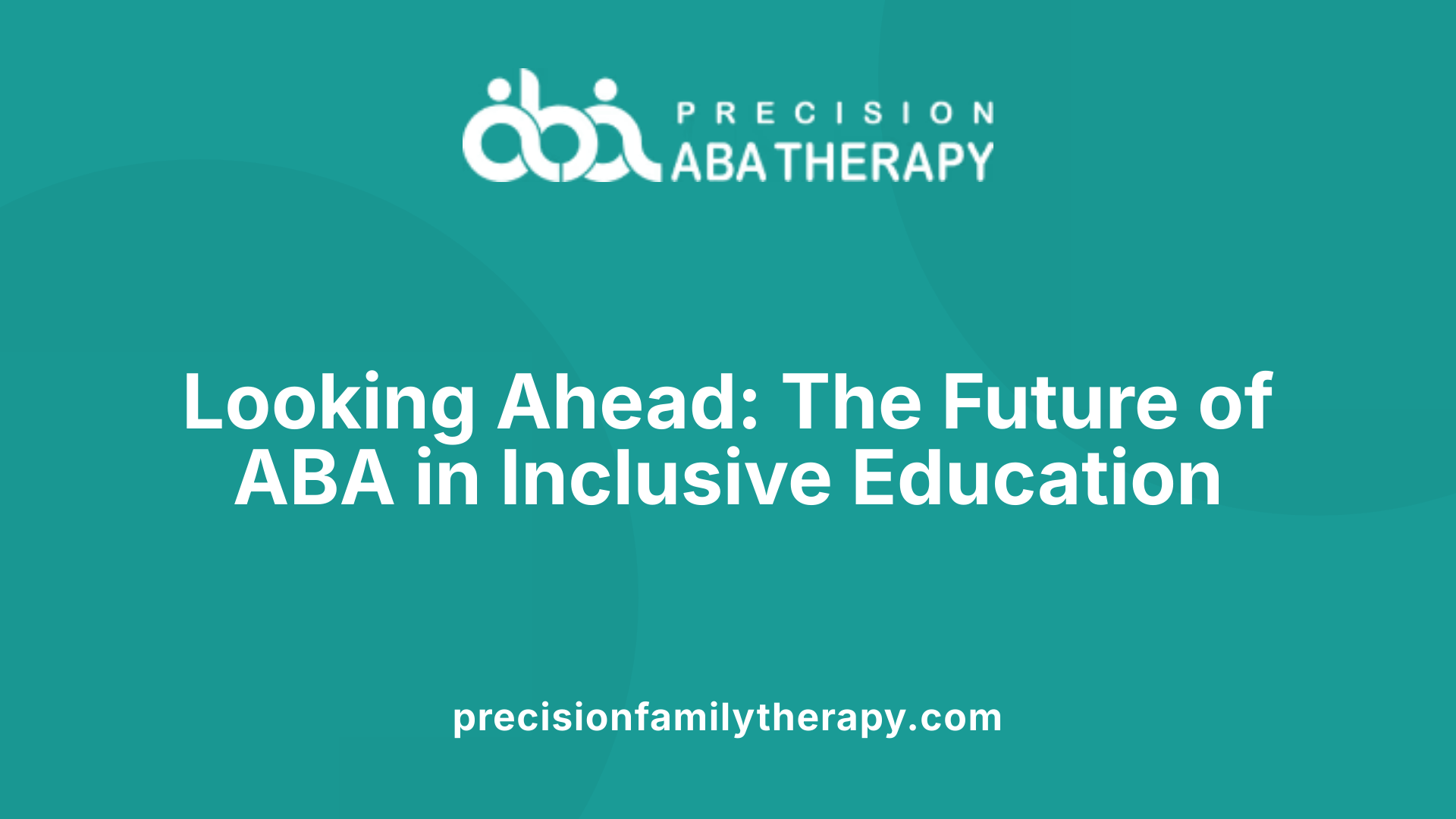
Emerging trends and technological advancements
Applied Behavior Analysis (ABA) continues to evolve with the integration of new technologies and innovative practices. Digital tools, such as apps and software, are increasingly used to record data, track progress, and deliver interventions more efficiently. Virtual reality (VR) and augmented reality (AR) are emerging as powerful mediums for immersive learning experiences tailored to individual needs. These advancements allow for more personalized, engaging, and accessible ABA interventions outside traditional settings.
Moreover, machine learning algorithms are being developed to analyze behavioral data, helping practitioners predict patterns and modify interventions proactively. Robots also play a role in therapy sessions, aiding in social skills development and motivating children with engaging, consistent interactions. These technological innovations promise not only to enhance effectiveness but also to expand access to ABA services, especially in remote or underserved communities.
Ongoing research and evidence base
Research within ABA remains robust, with continuous studies validating and refining intervention practices. Recent investigations focus on early intervention benefits, long-term outcomes, and the effectiveness of different ABA approaches such as Natural Environment Training (NET) and Pivotal Response Treatment (PRT).
A significant component of ongoing research is the emphasis on personalized interventions—adapting strategies to each child's unique profile. Evidence demonstrates that early, intensive ABA therapy can significantly improve communication, social, and cognitive skills.
The scientific community also explores the integration of ABA with other therapies, such as speech and occupational therapy, to optimize outcomes. As research advances, ABA's foundation remains solid, ensuring that interventions are data-driven and continuously improved based on the latest evidence.
Training and professional development for educators
Preparing educators to implement ABA techniques is critical for the widespread, effective application in inclusive classrooms. Specialized training programs and graduate courses in Applied Behavior Analysis provide teachers with the necessary skills to support students with diverse needs.
Professional development includes workshops on Discrete Trial Training (DTT), Pivotal Response Treatment (PRT), naturalistic strategies, and data collection methods. Teachers learn to modify environments, deliver reinforcement, and manage behaviors effectively, fostering positive and productive learning spaces.
Furthermore, collaborative training models involve BCBAs, RBTs, and classroom teachers working together to develop comprehensive support plans. Ongoing supervision and coaching ensure that educators stay updated on the latest research and best practices.
What is the role of an ABA-focused special education teacher?
An ABA-focused special education teacher develops tailored behavioral interventions, supervises their implementation, and collaborates with families to support individualized progress. They play a crucial role in translating research-based strategies into everyday classroom practice, ensuring that each student receives personalized support that fosters independence, communication, and social skills.
Looking Ahead
The future of ABA in inclusive education is promising, with technological innovations and an expanding evidence base driving more precise, engaging, and effective interventions. Continued investment in teacher training, research, and accessible services will help create more inclusive environments where all students with behavioral challenges can thrive.
Conclusion: The Transformative Power of ABA in Education
What are the main benefits and impact of ABA in education?
Applied Behavior Analysis (ABA) has profoundly transformed educational approaches for children with autism spectrum disorder (ASD) and other behavioral challenges. It is recognized as the 'gold standard' treatment, with a wealth of research showing its effectiveness in enhancing social communication, daily living skills, and reducing problematic behaviors. Through structured, data-driven strategies, ABA helps children gain independence, develop crucial academic and social skills, and integrate successfully into mainstream classrooms.
ABA’s flexible methods, such as discrete trial training (DTT), natural environment training (NET), and verbal behavior therapy (VBT), are tailored to individual needs. This personalization ensures that each child's goals—set collaboratively by therapists, teachers, and parents—are achievable and meaningful. The systematic tracking of behaviors through objective data collection allows for ongoing assessment and adjustment of interventions, leading to better learning outcomes.
The impact extends beyond individual improvement, fostering inclusive environments where children with diverse needs can thrive. Schools that implement ABA see reductions in disruptive behaviors, a more organized routine, and enhanced peer interactions, which contribute to a positive classroom atmosphere. Especially when integrated into Individualized Education Programs (IEPs), ABA supports students in meeting their unique potential.
How crucial is collaboration and teacher training in successful ABA implementation?
Effective ABA integration in educational settings hinges on robust collaboration among educators, therapists, and families. Regular communication and teamwork ensure that behavior intervention plans are consistent across environments, maximizing their effectiveness.
Training teachers and support staff in ABA techniques is vital. Techniques such as positive reinforcement, prompting, shaping, and data collection empower teachers to implement interventions confidently. Many schools offer professional development programs focused on ABA strategies, enabling staff to deliver individualized support and maintain fidelity to intervention plans.
Additionally, the use of Behavior Analysts—especially Board Certified Behavior Analysts (BCBAs) and Registered Behavior Technicians (RBTs)—provides expertise in designing and monitoring interventions. Their involvement in staff training, behavior assessments, and progress evaluations creates a foundation for sustained success.
What does the future hold for ABA in education and behavioral intervention?
Looking ahead, continued research and technological innovation promise to further refine ABA practices. Advances in data analysis, remote monitoring, and digital tools can enhance the precision and accessibility of ABA interventions.
The growing recognition of ABA’s effectiveness is leading to broader adoption in inclusive classrooms, mainstream schools, and community settings. As awareness increases, so does the emphasis on training more educators and professionals to deliver ABA-based supports.
Furthermore, integrating ABA principles with other approaches, such as social-emotional learning and sensory integration techniques, can create more holistic support systems for students.
By fostering ongoing collaboration among researchers, clinicians, and educators, the future of ABA in education is one of expanding possibilities. The goal remains to empower children with diverse needs to reach their full potential, promoting independence, social integration, and lifelong skills.
| Aspect | Details | Additional Notes |
|---|---|---|
| Main Benefits | Improves communication, behavior, social skills, and independence | Evidence-based, data-driven approach |
| Importance of Collaboration | Essential for consistency and success | Involves teachers, therapists, families |
| Teacher Training | Enables effective implementation | Includes techniques like reinforcement and data collection |
| Future Outlook | Incorporating technology and expanding inclusive practices | Focused on personalized, accessible interventions |
| Broader Applications | Used beyond autism for various behavioral challenges | Adaptable to different populations and settings |
Embracing a Brighter Future for Special Education with ABA
As ABA continues to demonstrate positive outcomes across various facets of special education, it underscores the importance of collaborative implementation, ongoing training, and research-driven practices. Embracing innovative technologies and expanding professional expertise will ensure that children with disabilities benefit from personalized, effective interventions. The future of ABA in inclusive education looks promising, fostering environments where every student can thrive and reach their full potential.
References
- The Connection Between ABA and Special Education: A Guide
- Applied Behavior Analysis Therapy: Helping Children With Special
- Benefits of Implementing ABA Therapy in Schools for All
- Benefits of Earning an ABA for Special Education Teachers | Regis
- What is Applied Behavior Analysis?
- ABA Inclusive Education: Revolutionizing Learning for All
- ABA and Special Education: An Overview - The IEP Attorney
- How to Use ABA in the Classroom
- Learning with ABA in Schools | Behavior Support in Schools
- How to Use ABA in the Classroom




